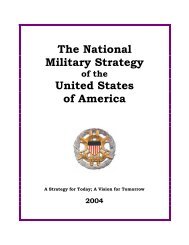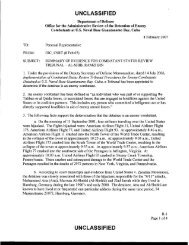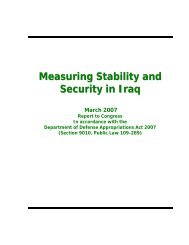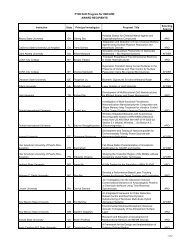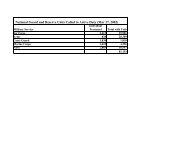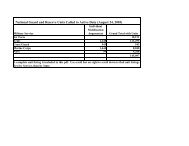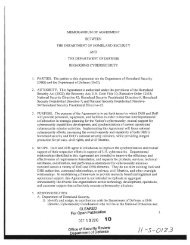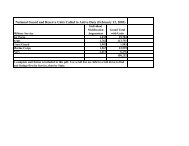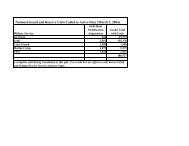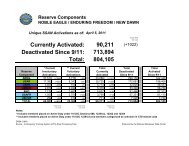Report - United States Department of Defense
Report - United States Department of Defense
Report - United States Department of Defense
You also want an ePaper? Increase the reach of your titles
YUMPU automatically turns print PDFs into web optimized ePapers that Google loves.
UNCLASSIFIED<br />
ANASOF currently operate at a high tempo, impacting the campaign far more than their<br />
numbers would suggest. However, for many <strong>of</strong> their operations they are dependent upon ISAF<br />
air transport, and in particular, helicopter lift. The AAF is not projected to be able to provide the<br />
ANASOF with enough helicopter mobility to make up for the departure <strong>of</strong> most ISAF forces in<br />
2014. As ISAF helicopter transport becomes less available, ANASOF will have to travel more<br />
by ground. As ground transportation is difficult in many areas <strong>of</strong> Afghanistan, and is inherently<br />
slower than air transport, this will result in diminished ANASOF effectiveness.<br />
Equipping and Enablers<br />
CSTC-A procured and delivered a high percentage <strong>of</strong> ANA-required equipment to Afghan<br />
depots during the reporting period. Of the three main categories <strong>of</strong> equipment required by the<br />
ANA (shoot, move, and communicate), CSTC-A delivered 114 percent <strong>of</strong> “shoot” equipment,<br />
91.2 percent <strong>of</strong> “move” equipment, and 99.5 percent <strong>of</strong> “communicate” equipment.<br />
However, delivering equipment to the national and regional depots does not mean that this<br />
equipment has reached personnel in the field. There is a shortfall in distribution between the<br />
regional depots and fielded units. Equipment shortages were reported in several key areas to<br />
include: medical, maintenance, mortars, night vision goggles, communications, CIED/ electronic<br />
countermeasure, and artillery Basic Issue Items. Shortages in CIED equipment also limit the<br />
ANP’s ability to conduct CIED operations. Planning for logistical sustainment <strong>of</strong> operations and<br />
supply forecasting remains a work in progress.<br />
The ANA’s main challenge in equipping its units continues to be the delivery <strong>of</strong> equipment from<br />
depots to the units deployed in the field. Each individual ANA unit is slated to receive<br />
equipment that has been released from the national depots, shipped through the ANA Central<br />
Movement Agency, and delivered to ANA Regional Logistic Support Commands (RLSC).<br />
RLSCs subsequently issue the equipment to the field units. Some RLSCs have warehoused<br />
equipment waiting to be issued, while nearby units in the field are forced to operate in an underequipped<br />
state. CSTC-A has limited ability to track equipment once it is delivered to the depots,<br />
although the equipment levels <strong>of</strong> partnered units in the field are tracked under the Commanders<br />
Unit Assessment Tool (CUAT) system. Recent visits at Kabul Airport (KAIA), for example,<br />
identified excessive requisitioning for aircraft parts that were visibly available at the RLSC but<br />
that were not being issued. ANA RLSCs will need continued support from advisors to improve<br />
efficiencies and troubleshoot logistics bottlenecks.<br />
Although NTM-A does not track most equipment that has been fielded to the kandak level,<br />
CSTC-A conducts 100 percent annual accountability <strong>of</strong> night vision devices and quarterly<br />
inspections <strong>of</strong> serial-numbered Class VII items such as vehicles, radios and weapons in<br />
accordance with U.S. end-use monitoring law and regulation laws and regulations. CSTC-A<br />
conducts routine inspections <strong>of</strong> weapons that have been transferred to the MoD and MoI to<br />
ensure end-use compliance.<br />
By the end <strong>of</strong> ISAF’s mission in 2014, U.S. and coalition enabler support (close air support,<br />
medevac, direct fire, ISR) to the ANSF will be withdrawn, creating gaps which, if not addressed,<br />
will reduce GIRoA’s ability to provide security for its populace and deter external threats. The<br />
69



